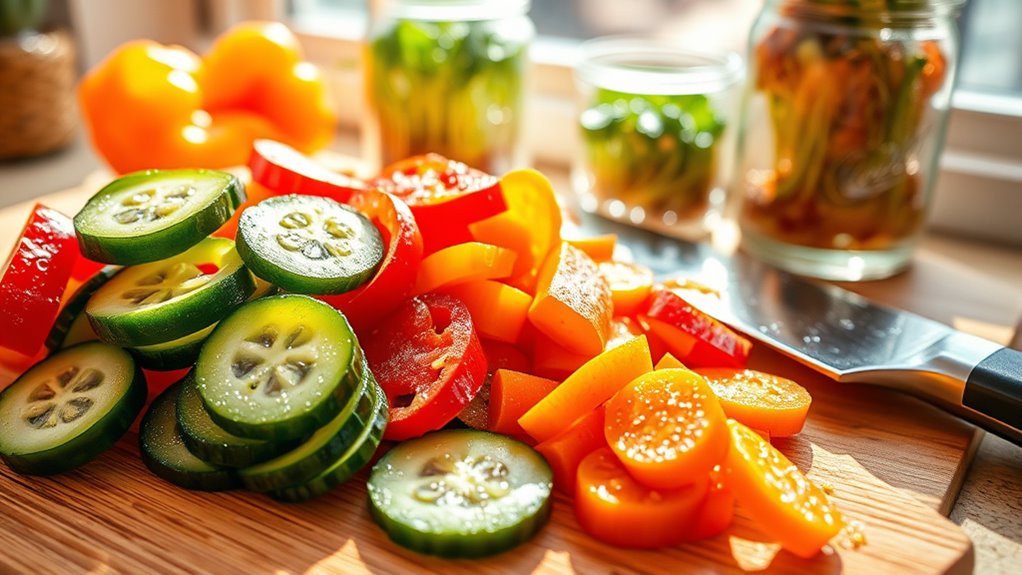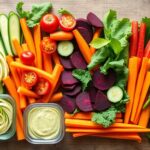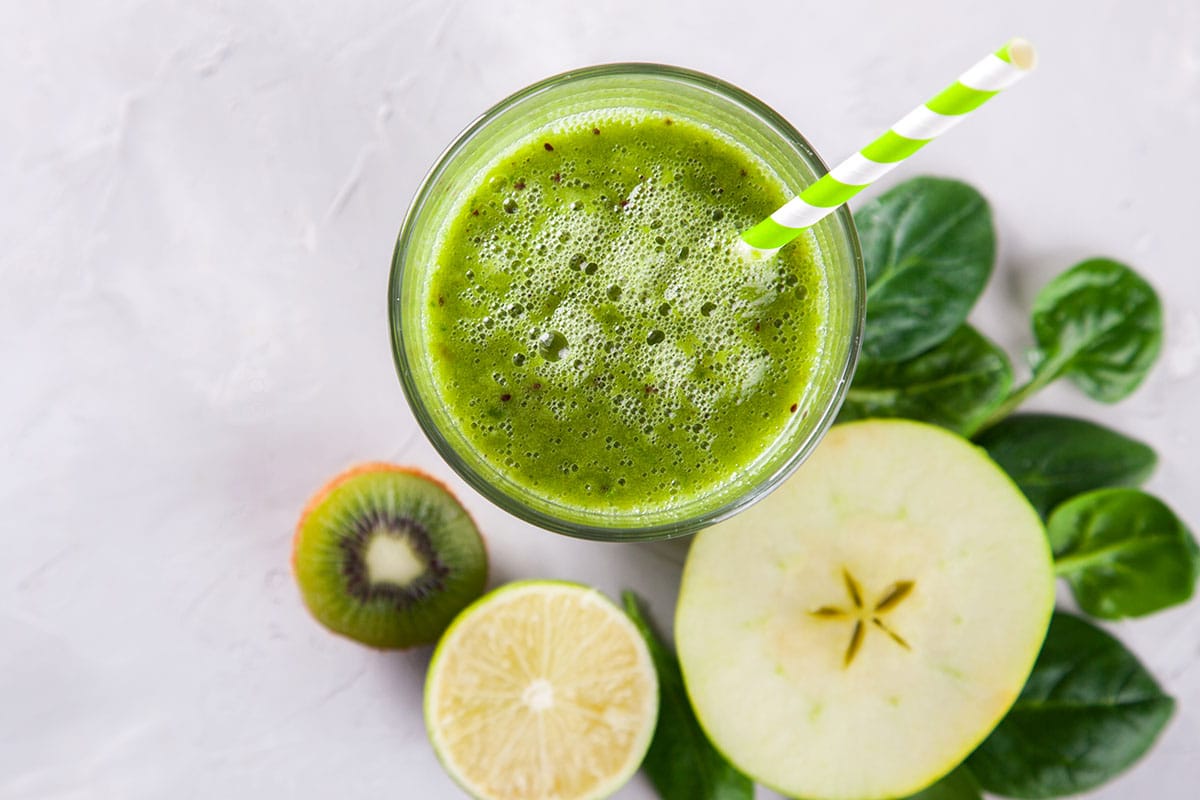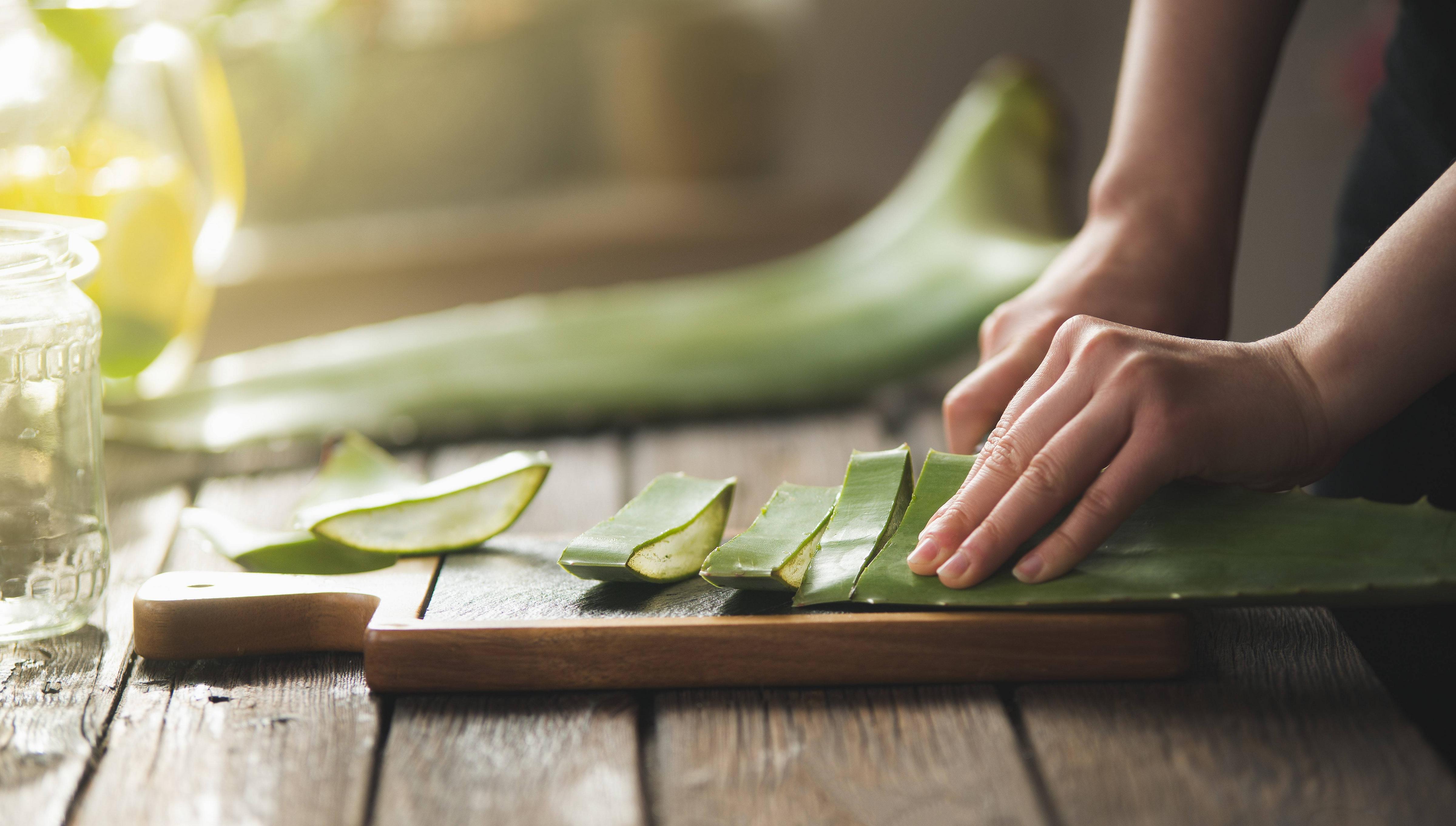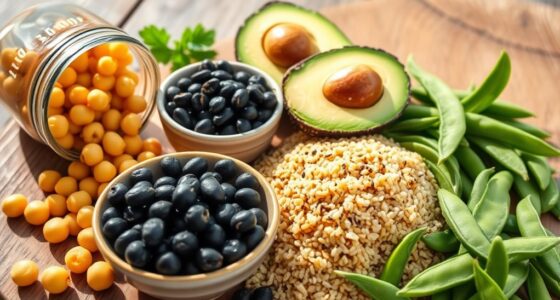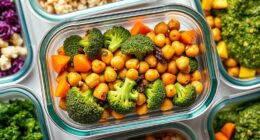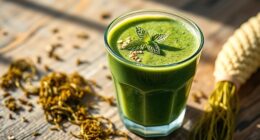To guarantee raw food safety, always select fresh, blemish-free ingredients and store them properly in the fridge below 40°F, keeping raw meats separate from produce and cooked items. Wash your hands and utensils thoroughly before handling, and use separate cutting boards for raw and cooked foods. Cook meats to recommended temps and reheat leftovers safely. Avoid cross-contamination by following proper storage and hygiene practices—your next steps will guide you even further.
Key Takeaways
- Properly wash all raw produce and ingredients to remove bacteria and parasites.
- Keep raw foods separate from cooked and ready-to-eat items to prevent cross-contamination.
- Store raw meats at or below 40°F (4°C) and use airtight containers to prevent spoilage.
- Cook meats to recommended internal temperatures using a food thermometer to eliminate pathogens.
- Maintain strict kitchen hygiene, including regular cleaning of surfaces, utensils, and hands.
Understanding Raw Food Risks and Benefits
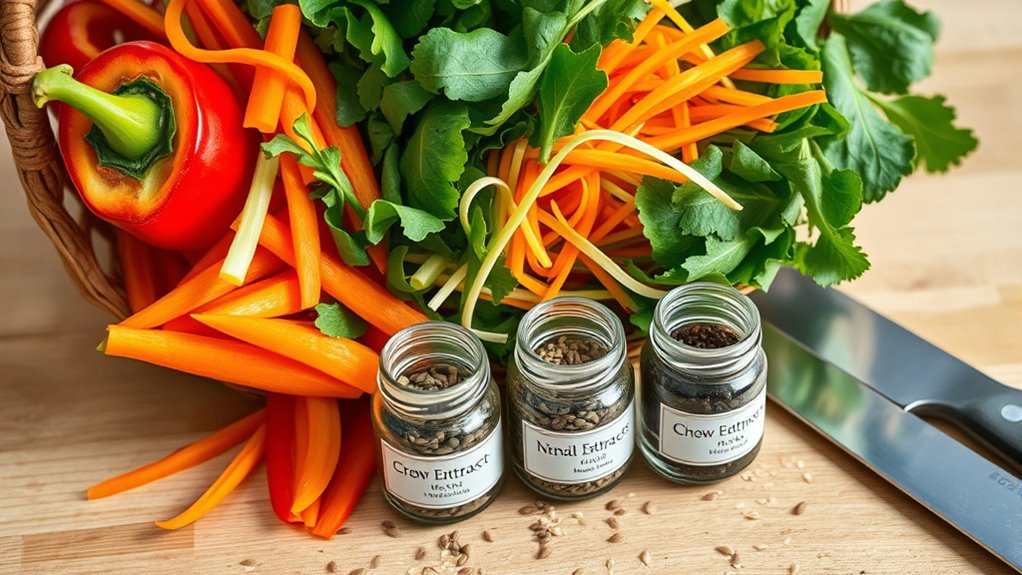
While raw foods can offer enhanced flavors and retain more nutrients, they also pose specific health risks if not prepared properly. Proper handling helps maximize nutrient preservation, ensuring you get the essential vitamins and minerals. When done correctly, raw foods also provide natural flavor enhancement, making dishes more vibrant and fresh. Additionally, implementing automation technologies in food processing and handling can improve safety standards and reduce contamination risks. Using temperature control techniques further minimizes bacterial growth during preparation and storage. Proper sanitation practices and understanding food safety protocols are also essential to prevent cross-contamination and ensure safe consumption. Conducting regular quality checks on ingredients can further reduce the likelihood of foodborne illnesses. However, you must be cautious, as raw ingredients can harbor bacteria or parasites that cause illness. Washing thoroughly and choosing high-quality, fresh produce reduces these risks. Understanding these benefits and dangers allows you to enjoy raw foods safely, enjoying their true flavors and nutritional value without compromising your health. Remember, a careful approach to raw food preparation helps you reap the full benefits while minimizing potential health issues.
Proper Selection and Storage of Raw Ingredients
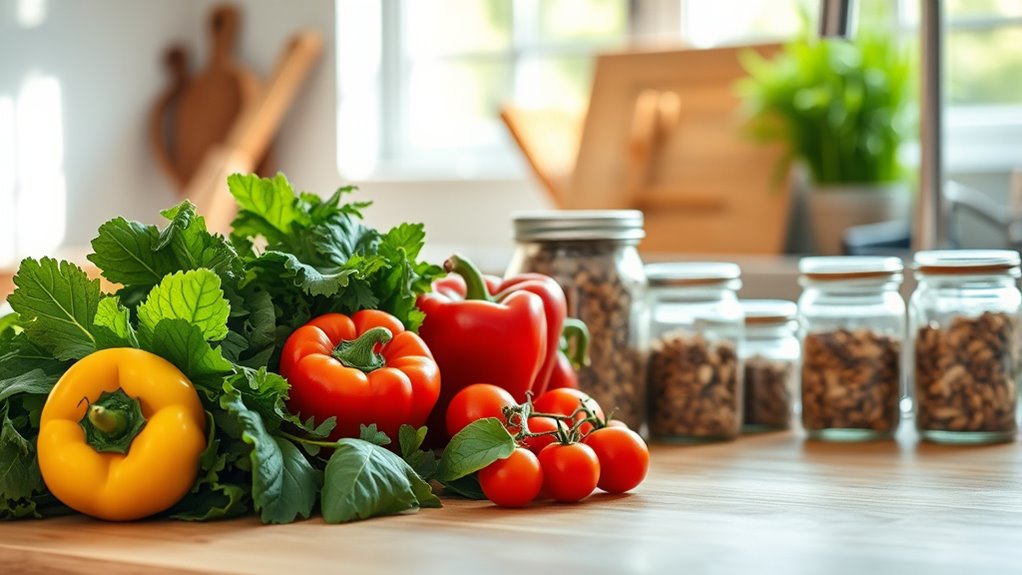
Choosing the right raw ingredients starts with selecting fresh, high-quality produce and proteins. Fresh produce should look vibrant, feel firm, and be free of bruises or mold. Proteins must be stored cold and handled with clean utensils to prevent contamination. Proper storage is essential to maintain freshness and ensure kitchen hygiene. Keep raw ingredients separate from cooked foods and ready-to-eat items to avoid cross-contamination. Use airtight containers or crisper drawers to extend shelf life. Regularly check for spoilage, such as bad odors or slimy textures, and discard unsafe items promptly. Remember, good selection and storage practices help prevent foodborne illnesses and preserve the nutrients and flavors of your raw ingredients. Proper handling today safeguards your health tomorrow. Additionally, understanding food safety protocols can further reduce the risk of contamination, including practices such as proper temperature control during storage and preparation. Maintaining hygienic handling can significantly lower the chance of bacteria transfer and spoilage. Incorporating food safety measures into your routine ensures a safer and more nutritious raw food experience. Being aware of food safety regulations also helps ensure compliance and reduces liability.
Safe Preparation and Handling Techniques
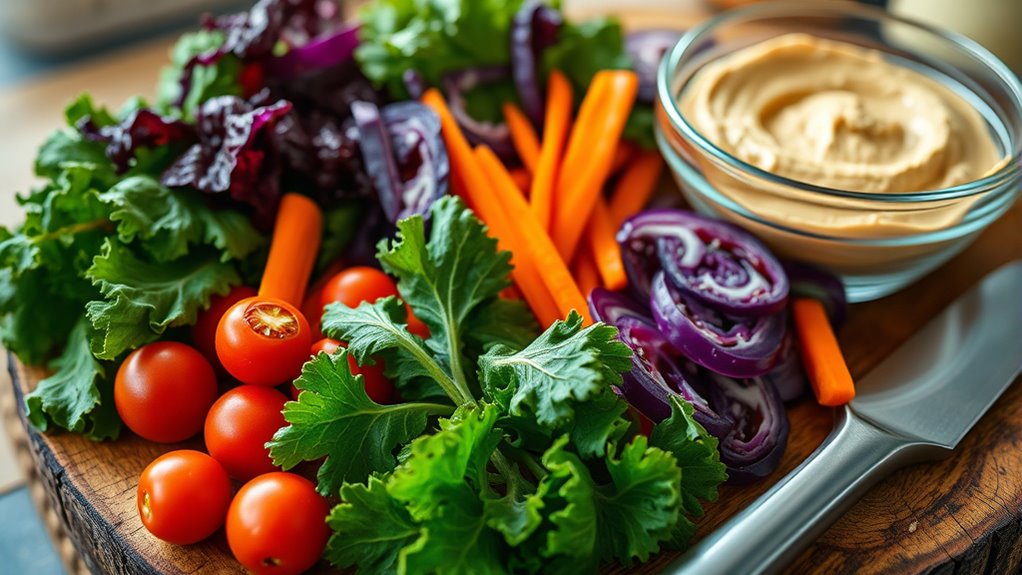
After selecting and storing your raw ingredients properly, it’s important to handle them with care during preparation to prevent contamination. To do this, prioritize utensil hygiene by thoroughly washing knives, cutting boards, and bowls after each use. Always keep raw produce separate from other ingredients to avoid cross contamination. Use the table below to guide your handling techniques:
| Step | Action | Tip |
|---|---|---|
| Wash hands | Wash hands before and after handling | Use soap and warm water |
| Clean utensils | Sanitize all tools regularly | Use vinegar or mild bleach solution |
| Separate equipment | Use different utensils for raw items | Color-code if possible |
| Store properly | Keep raw ingredients separate | Store in airtight containers |
| Maintain cleanliness | Wipe surfaces frequently | Use food-safe disinfectants |
Following these techniques guarantees safe preparation and minimizes the risk of cross contamination. Proper handling of raw food reduces contamination risk and is essential to ensure safety and freshness throughout your culinary process. Regularly inspecting your cleaning and maintenance routines can further enhance food safety. Additionally, employing proper handling techniques can help preserve the nutritional quality of your ingredients. Incorporating food safety guidelines into your routine can also support consistent practices and reduce potential hazards.
Recognizing and Preventing Contamination
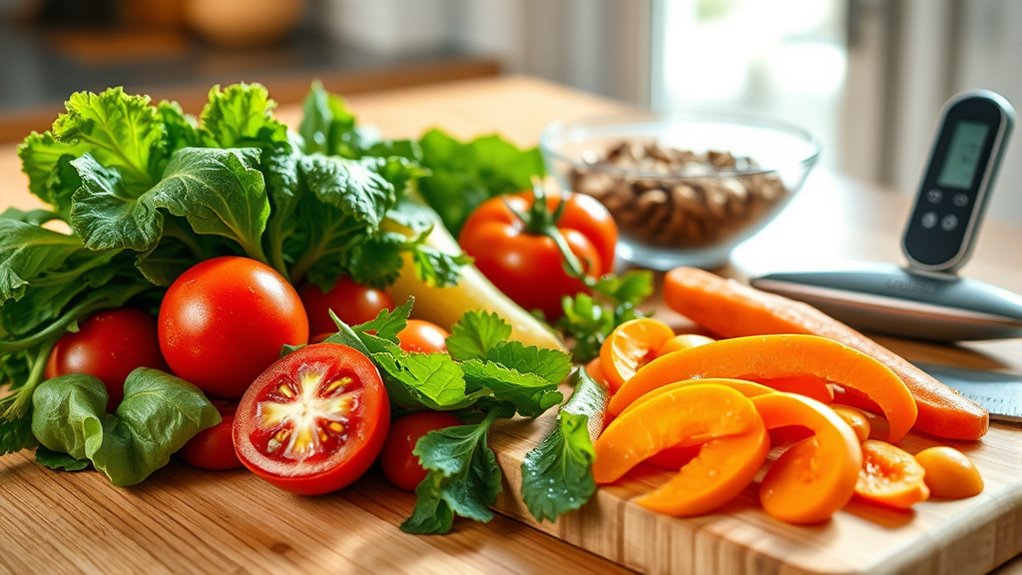
Contamination can occur at any stage of food handling, making it essential to recognize the signs and understand how to prevent it. You should always practice proper kitchen sanitation, such as cleaning surfaces regularly and washing your hands thoroughly. Avoid cross-contamination by keeping raw foods separate from cooked or ready-to-eat items. Be aware that food irradiation can reduce harmful bacteria, but it’s not a substitute for proper handling. Here are some key strategies:
- Maintain strict kitchen sanitation to eliminate bacteria.
- Store raw foods properly to prevent cross-contact.
- Use separate cutting boards for raw produce and other ingredients.
- Always inspect food for signs of spoilage or contamination before consuming.
- Recognizing food contamination fails, such as improper storage or handling, helps prevent foodborne illnesses. Ensuring proper food safety protocols during all stages of preparation is crucial to maintaining food quality and safety. Additionally, understanding how improper handling of raw foods can introduce bacteria is vital for effective prevention. Regular training on food safety standards can further reduce risks associated with raw food contamination. Practicing proper air purifier maintenance in your kitchen can also help reduce airborne contaminants that may settle on food surfaces.
Tips for Safe Consumption and Storage at Home
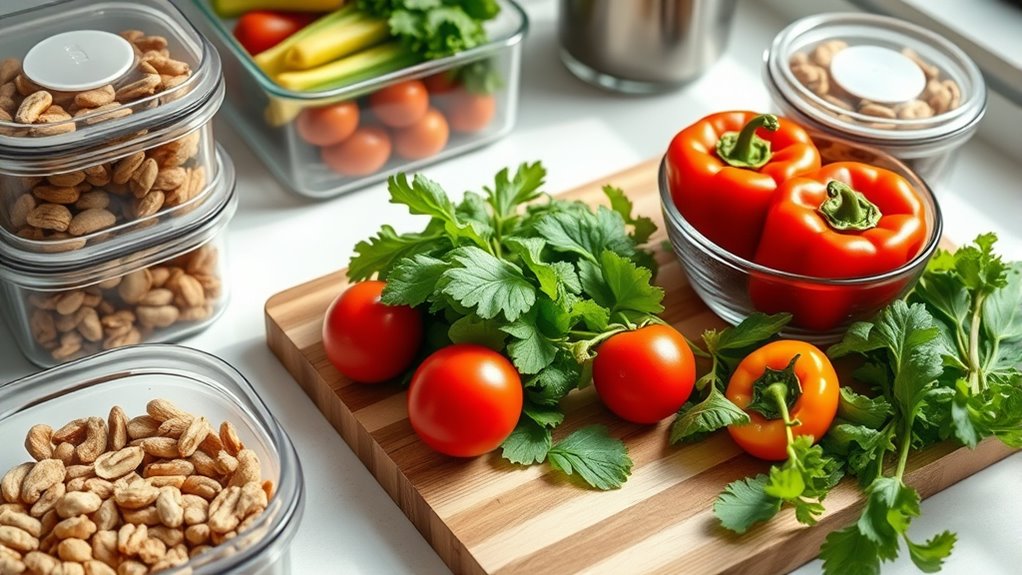
Proper storage and careful consumption are essential to keeping your food safe after purchase. To avoid falling for raw food myths, always wash produce thoroughly and store it separately from cooked foods. Use airtight containers to prevent cross-contamination and keep your fridge at the right temperature, ideally below 40°F (4°C). When preparing raw foods, practice kitchen safety by washing your hands and cutting boards frequently. Be cautious of common misconceptions, like the idea that all raw foods are safe without proper handling. Keep raw meat away from other ingredients, and consume perishable items promptly. Additionally, using a vetted home theatre projector can enhance your viewing experience while ensuring proper food setup in your entertainment space. These practices help prevent bacterial growth and ensure your raw food stays fresh and safe to eat. Staying vigilant with storage and hygiene is your best defense against foodborne illness.
Frequently Asked Questions
Can Raw Foods Be Safely Consumed During Pregnancy?
During pregnancy, you might wonder if raw foods are safe to eat. While raw food can be nutritious, it also poses raw food risks like bacteria and parasites that could harm you or your baby. For ideal pregnancy nutrition, it’s best to avoid raw seafood, eggs, and unpasteurized dairy. Cooking foods thoroughly reduces these risks, helping you enjoy raw foods safely during pregnancy. Always consult your healthcare provider for personalized advice.
Are There Specific Certifications to Look for on Raw Food Products?
When choosing raw food products, you should look for certification standards and quality labels that guarantee safety and quality. Certifications like USDA Organic or Non-GMO Project verify that the product meets strict guidelines. These labels give you confidence that the raw foods are free from harmful chemicals and contaminants. Always check for reputable certification standards to make informed, safe choices and enjoy your raw food journey with peace of mind.
How Do I Tell if Raw Food Has Gone Bad?
Imagine opening your raw food and noticing a sour smell or slimy texture—that’s food spoilage signaling bacterial growth. You’ll see discoloration or mold, and if it feels sticky or off when touched, it’s time to discard. Trust your senses; if anything seems unusual, avoid eating it. Food spoilage usually shows visible signs or bad odors, so always check your raw foods carefully to prevent illness.
Is It Safe to Reuse Raw Food Packaging?
Reusing raw food packaging isn’t always safe. You should consider packaging hygiene and reuse safety first. If the packaging is clean, free of tears, and has no residue or odors, it might be okay to reuse for non-food items. However, for food storage, it’s better to use new, food-grade containers to prevent contamination. Always prioritize safety and cleanliness to avoid health risks.
What Are the Risks of Raw Food Cross-Contamination With Cooked Foods?
Imagine your kitchen as a busy highway, where raw foods are cars and cooked foods are pedestrians. Cross contamination risks happen when raw chicken, for example, spills bacteria onto cooked veggies. To prevent this, you need to follow cross contamination prevention strategies and use proper storage techniques. Keep raw meats separate, store them below cooked foods, and clean surfaces thoroughly to lower the risk of harmful bacteria spreading.
Conclusion
By following these tips, you’ll turn your kitchen into a safe haven, where vibrant vegetables and fresh fruits await your careful touch. Picture a clean countertop, crisp produce, and a gentle breeze of confidence guiding your hands. With each mindful step, you protect yourself from hidden dangers, ensuring every bite is as nourishing and invigorating as a garden in full bloom. Embrace these practices, and enjoy raw foods that delight your senses safely and deliciously.
Hi, I’m Alexander. I’m a vegan of over 20 years, and I initially made the switch for health reasons. However, as time went on, I became more and more passionate about the ethical and environmental implications of leading a vegan lifestyle.
I am the author of The Graceful Kitchen, a vegan blog where I share recipes for delicious and nutritious vegan meals. As someone who is deeply committed to living a cruelty-free life, I am also a strong advocate for using whole foods as the foundation of a healthy diet – and believe that going vegan is one of the best ways to achieve this.
